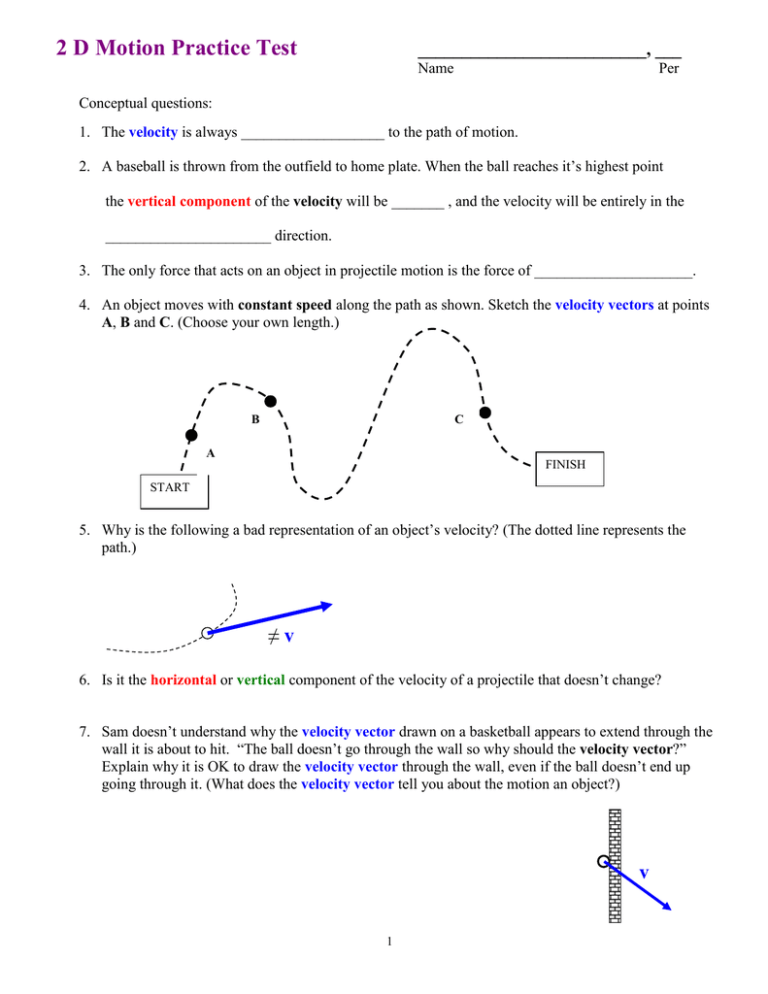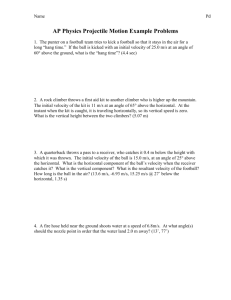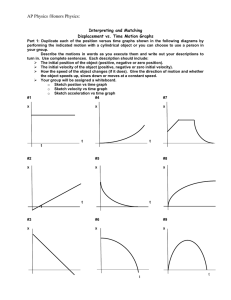2 D Motion Practice Test
advertisement

2 D Motion Practice Test __________________________, ___ Name Per Conceptual questions: 1. The velocity is always ___________________ to the path of motion. 2. A baseball is thrown from the outfield to home plate. When the ball reaches it’s highest point the vertical component of the velocity will be _______ , and the velocity will be entirely in the ______________________ direction. 3. The only force that acts on an object in projectile motion is the force of _____________________. 4. An object moves with constant speed along the path as shown. Sketch the velocity vectors at points A, B and C. (Choose your own length.) B C A FINISH START 5. Why is the following a bad representation of an object’s velocity? (The dotted line represents the path.) ≠v 6. Is it the horizontal or vertical component of the velocity of a projectile that doesn’t change? 7. Sam doesn’t understand why the velocity vector drawn on a basketball appears to extend through the wall it is about to hit. “The ball doesn’t go through the wall so why should the velocity vector?” Explain why it is OK to draw the velocity vector through the wall, even if the ball doesn’t end up going through it. (What does the velocity vector tell you about the motion an object?) v 1 8. A bowling ball rolls off the edge of a cliff with an initial velocity of 11.2 m/s, directed at an angle of 26.6o below the horizontal. Make the upward direction positive. A) Find the horizontal and vertical components of vo: vox = ________________________ = _______ (alg) voy = ________________________ = ______ (#) (alg) (#) B) Carefully sketch the path of the ball for the first 3 seconds. For simplicity, assume g = 10 m/s2 for this problem. Make a motion table first… C) Sketch the velocity of the ball at 0, 1, and 2 seconds. D) Find the magnitude and direction of the velocity at 2.0 seconds. y 10 m 0 20 m 30 m x v0 -20 m -40 m -60 m 2 9. Dukes of Hazard. Luke Duke is up to his old tricks again. This time he is attempting to complete a jump that is a horizontal distance Δx across. vo Δx A) Write down the horizontal equation of motion for Δx. B) Use a vertical equation of motion to find the time Δt required by the car to complete the jump in terms of vo and . C) Combine your results from A) and B) to get the “Range Equation” for Δx in terms of vo and θ. You may need to use the double angle formula: 2 cos θ sin θ = sin (2θ) D) Find the speed vo required to clear the pothole given Δx = 30 m and = 15o. 3 10. You are an incurable (if misguided) romantic. In an effort to impress your beloved, you scoop up a bouquet of flowers, put on your goggles and climb into a giant sling-shot. Your plan is to fire yourself through your beloved’s open window. The center of the window is located 45 vertical meters up. The slingshot will launch you with at an angle of θ = 60 degrees above the horizontal. You intend to enter the window at the high point of your flight. A) At what speed vo must you be launched with to enter the window at the highpoint of your flight? (Hint: use a vertical equation of motion.) Δy = 45 m vo θ = 600 B) What will the horizontal component of your velocity be when you pass through the window? C) Your beloved feels a slight chill and moves to shut the window 1.5 seconds after you have launched. What happens? D) How far over (Δx) is the base of the house from your launch point? 4






